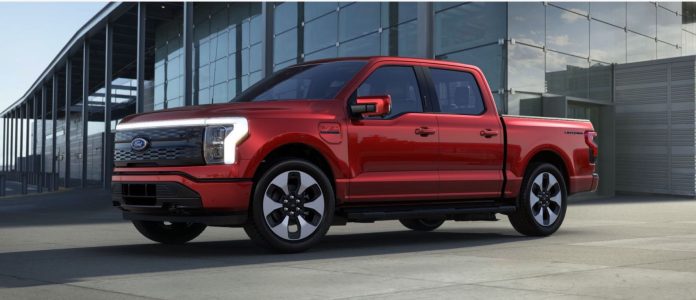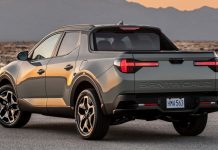The Ford F-150 Lightning is more than the usual. It deserves a really close look and a detailed evaluation. This will be one of several videos I do prior to posting the usual full-length review.
The truck arrived later than usual – because it took longer than usual to drive it to my place here in SW Virginia, which is about 240 miles away from the “press pool” in the DC area. As it happens, 240 miles is the touted range of the standard 2023 Lightning on a full charge (a slight increase over the 230 miles touted by the ’22 model). As it turned out, the driver had to stop twice along the way to get more range. Because it didn’t have enough juice to travel the touted 230 (240) miles on a full charge.
It arrived with 180 miles of indicated range remaining. We’ll see how far it actually goes – which I will report about in Part II, probably later today. My plan is to drive it into Roanoke, Va. – which is about 35 miles away – and back home again, a round trip of 70-ish miles. Which ought to be well within the remaining indicated range of 180 miles.
I am hoping I will not have to stop (and wait) along the way – for a “fast” charge – in order to be able to make it back home.
Speaking of “fast” charging . . .
I took a look at the instruction book that came with the truck, where it counsels care about “fast” charging . . . if you care about the long-term health of the battery. Which is something you would probably care a great deal about, if you owned this truck – and wanted to avoid having to buy a new battery for as long as possible. “AC charging” – by which is meant trickle-charging on household 120-240V AC current – “is the preferred method as it preserves the health of the battery.”
Italics added.
“DC charging” – that is, “fast” charging – “allows you to charge your vehicle’s high-voltage battery in significantly less time” at a commercial “fast” charging station where very high DC voltage is available. That is what makes it possible to “fast” charge an EV.
Everyone knows that, because everyone has heard that. I think it’s significant that – to my knowledge – no automotive journalist has pointed out that it is preferable to not “fast” charge, assuming you wish to preserve the health of the battery. But that means a lot more waiting, as it takes at least several hours to recover even a partial charge using 120-240V AC household power. Which is the only kind of power available, by the way, at private residences.
This is ok if you’re home – and don’t need to leave anytime soon. But what if you aren’t – and do?
The conundrum thus appears to be:
Use the DC “fast” chargers available commercially (not residentially) so as to not have to wait for several hours – and so be able to use the vehicle to get where you need to be as opposed to where you’re stuck for awhile – and risk the “health” of the battery – or plan around the several hours’ wait for each 120-240V AC trickle-charge, in order to preserve the health of the battery.
Meanwhile, a gas-engined F1-50 could easily have made the 240 mile trip to my place without stopping and had at least that much range remaining. I could also “fast” fuel it – without any risk to the engine (or gas tank) in about five minutes, at the gas station just down the road from me.
I hope I am not coming off as unduly harsh on the Lightning. I intend to just state the facts – and let them speak for themselves.
Part II will encompass my first test-drive from here – my place in SW Virginia – to there (downtown Roanoke) and then (hopefully) back again.
If you don’t hear from me for awhile, you’ll know why!
Part II is here.
. . .
Got a question about cars, Libertarian politics – or anything else? Click on the “ask Eric” link and send ’em in! Or email me at EPeters952@yahoo.com if the @!** “ask Eric” button doesn’t work!
If you like what you’ve found here please consider supporting EPautos.
We depend on you to keep the wheels turning!
Our donate button is here.
If you prefer not to use PayPal, our mailing address is:
EPautos
721 Hummingbird Lane SE
Copper Hill, VA 24079
PS: Get an EPautos magnet or sticker or coaster in return for a $20 or more one-time donation or a $10 or more monthly recurring donation. (Please be sure to tell us you want a magnet or sticker or coaster – and also, provide an address, so we know where to mail the thing!)
My eBook about car buying (new and used) is also available for your favorite price – free! Click here. If that fails, email me at EPeters952@yahoo.com and I will send you a copy directly!











The one to buy is the hybrid with the optional 7.2kW pure sine wave inverter.
So you can run your house off of it during a power outage w/ no need for a separate genny.
As an RC racer, my fellow racers and I routinely charge our Lipo batteries at 30 to 40C. It’s fast and allows us to transition quickly between races and different classes. We are strongly encouraged to keep the batteries in fireproof bags as they charge to mitigate risk. Some tracks and large events make it mandatory.
Others believe that this hi amperage charging ‘packs’ the batteries with more power but most importantly it warms the cells which improves current flow during the race.
The tradeoff is the risk factor as the batteries can potentially explode endangering others and property. Additionally, the batteries will puff in short order rendering them unuseable and even more dangerous and vulnerable to fire. Even small lipo fires are dangerous and difficult to extinguish.
Even at low C rates, knowing the risks, I can’t imagine sitting on top of a gigantic lithium battery pack!
Hi Bax,
I’m cursing the warm weather we’re having – because I’m hoping to see what cold does to charge. I have the truck until next Weds. so we’ll see… maybe.
The only really appropriate piece of this puzzle is the name of the truck.
It will be busy “lightening ” your wallet, while worry you about whether or not it will catch fire and cook you inside, like you’d been hit by Lightning!!!
“I took a look at the instruction book that came with the truck, where it counsels care about “fast” charging . . . if you care about the long-term health of the battery…“AC charging” – by which is meant trickle-charging on household 120-240V AC current – “is the preferred method as it preserves the health of the battery.”
Italics added.
[N]o automotive journalist has pointed out that it is preferable to not “fast” charge, assuming you wish to preserve the health of the battery.”
This means one thing, Eric. Today’s “automotive journalist” can write but, they cannot read.
Well at least it’s in the owner’s manual. Telling people that fast charging is not good for batteries seems an uphill battle much of the time. When a replacement battery is so very expensive it makes the quoted fast charge times irrelevant emergency use only information.
Hi Brent,
Yup. And – try to imagine an automaker advising the owner of, say, a high-powered car to be careful about using that power as using it will increase the likelihood of premature engine failure…
It gives them a “get out of litigation free” card. Well, we told you using DC fast chargers would reduce the life of the pack and you went ahead and did it anyway. So that new battery pack after 4 years is on you!
https://www.fordservicecontent.com/Ford_Content/vdirsnet/OwnerManual/Home/Content/
sorry about the bad link. I was hoping to get something a little less messed up.
I hate the what the web has degraded into…
https://www.fordservicecontent.com/Ford_Content/vdirsnet/OwnerManual/Home/Content?variantid=8821&languageCode=en&countryCode=USA&Uid=G2235517&ProcUid=G2177680&userMarket=USA&div=f&vFilteringEnabled=False&buildtype=web
Until batteries in electric vehicles can be replaced by something that actually works practically and affordable, I don’t see how large scale adoption can happen.
And it still doesn’t answer the question, why bother to begin with? Gas, diesel and natural gas all work much better.
I find your discovery extremely interesting. Biden wants what? $5 billion to put fast chargers all over to make these things viable, yet they are recommended against?
I have a lot of experience with high drain battery applications, and have run many measured records of battery life. Modern LiPo batteries don’t like to be charged at a rate greater than about 1C. 1C means its entire capacity is filled in an hour, so a 150 kWh battery shouldn’t be charged at more than 150kW, for example. Ideally, you charge it at 0.5C or less, meaning it takes about two hours at peak charge rate (it will have to slow down past about 80% state of charge, irrespective of initial rate. It’ why fast chargers are only fast for the first part of the pack).
Discharging is always harsh on the battery in terms of C rate. Your F150 has about 400HP, which is a bit over 300kW of motor power. With a 100kWh battery pack, at max power, you discharge it at 3C – 3x the rate at which it starts to degrade.
I can go into excruciating detail here, but simplifying. Pardon any oversimplifications.
‘Ideally, you charge it at 0.5C or less, meaning it takes about two hours at peak charge rate.’ — OppositeLock
So you can save your own time, by charging at an aggressive 1.5 or 2.0C in 30 to 45 minutes … or, you can extend the battery’s life by charging at a leisurely 0.5C.
Sounds like an irresolvable conundrum involving an existential choice … unless you lease your EeeVee. Then you pump it mercilessly with a fire hose of electrons, as its battery writhes in pain. Who cares?
IC engines present no such riveting dilemma. Five minutes at the pump and you’re done, not having done any damage by fueling too fast. Living right is its own reward.
Thanks, OL!
The dilemma seems to be: Charge it “fast” – and risk faster battery degradation. Or charge it slow – and organize your driving around hours’-long waits.
Also if you were closer I’d be glad to loan you a nice tandem axle gooseneck with something fun on it to do load testing…
Good luck with this one. Looking forward to reading your reviews. For me the single biggest selling point of an EV is the amazing quietness. But I’m an old deaf guy who sacrificed his hearing to big guns, wind noise, and lots of wonderful performance engines. Buy the ticket enjoy the ride…
Hopefully you can add some load to it. Maybe a couple of your bikes? Or a trailer would be easier. It’s hard and dangerous trying to get 400lb+ bikes in a pickup without a solid ramp you can back up too.
Godspeed Eric Peters!
Most likely, AC charging is rectified to DC on-board, and current limited. Whereas external DC fast charging, presumably, can bypass the current limit of the internal rectifier.
Somewhere the specs should be available to detail the limit imposed on DC current, when AC charging is used.
In the video, I don’t understand the vertically split range gauge (179 miles). There’s a green arc on the left with a lightning bolt, a blue arc on the right with a gas pump (?). Not intuitive to me what they mean.
Electric bicycles make sense to me, they are light and have a mass less than the rider, thus electrifying a bicycle is logical and an exercise in efficiency.
But electrifying a heavy truck, does that make sense?
“The 2022 F-150 Lightning Pro with the smaller standard-range 98 kWh battery pack has a base curb weight of 6,171 lbs and a GVWR of 8,250 lbs. It also puts the base Lightning payload at just over the promised 2,000 lbs.
The Lightning with the larger 131 kWh extended-range battery has a curb weight of 6,590 lbs, according to the document (see below). This one has a GVWR of 8,550 lbs – which makes is a “heavy-duty” class 2b pickup truck. ”
And the charging times according to Ford:
https://media.ford.com/content/dam/fordmedia/North%20America/US/product/2022/f-150-lightning/pdf/F-150_Lightning_Tech_Specs.pdf
Severe range limitations PLUS severe refueling times.
What about the cost of electric vs. ICE engine? If the capital cost was far less then perhaps the loss of range and increase in refueling time would make it attractive.
https://carbuzz.com/compare/ford-f-150-vs-ford-f-150-lightning
Ebike batteries are pretty dangerous. They bounce around city streets with very little suspension, aren’t usually cared for and have sketchy battery management systems. Many/most ebikers set the assist to full or worse just use the manual throttle instead of pedaling at all, which means the current loads are much higher than necessary to move.
It is fun to cruise along at 25 MPH while barely working though.